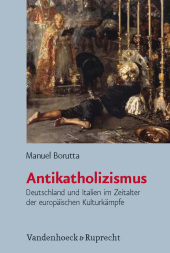 Neuerscheinungen 2011Stand: 2020-01-07 |
Schnellsuche
ISBN/Stichwort/Autor
|
Herderstraße 10
10625 Berlin
Tel.: 030 315 714 16
Fax 030 315 714 14
info@buchspektrum.de |

Manuel Borutta
Antikatholizismus
Deutschland und Italien im Zeitalter der europäischen Kulturkämpfe
2. Aufl. 2011. 488 S. mit 40 Abb. 23.7 cm
Verlag/Jahr: VANDENHOECK & RUPRECHT 2011
ISBN: 3-525-36849-6 (3525368496)
Neue ISBN: 978-3-525-36849-7 (9783525368497)
Preis und Lieferzeit: Bitte klicken
Der Kulturkampf als Kaleidoskop - gesellschaftliche und kulturelle Dimensionen eines europäischen Phänomens.
Der Mönch als Ungeziefer, der Priester als Triebtäter - das sind nur zwei Bilder, mit denen die fortschrittlichen Kräfte, u.a. Liberale und Demokraten, gegen den Katholizismus zu Feld zogen. Der moderne Antikatholizismus war bereits in der Aufklärung entstanden und entwickelte sich in der Folge zu einem europäischen Konflikt um den Ort und die Bedeutung von Religion und Kirche. Manuel Borutta erhellt im Rahmen eines Vergleichs zwischen Deutschland und Italien den Zusammenhang zwischen Antikatholizismus, Kulturkampf und Säkularisierungstheorie. Er zeigt, wie sich der Antikatholizismus vor 1800 mit Projekten der Moderne und der bürgerlichen Gesellschaft verband, sich im 19. Jahrhundert medial ausbreitete, Kulturkämpfe auslöste und nach 1900 in die Selbstbeschreibung der westlichen Moderne einging.
The cultural struggle as a kaleidoscope the social and cultural dimensions of a European phenomenon.
Monks as vermin, priests as sex offenders those are only a few of the images that progressives, both liberals and democrats alike, have employed in their fight against Catholicism. Modern anti-Catholicism first arose during the Renaissance and developed over time into a conflict about the place and meaning of religion and church in general. Manuel Borutta illuminates the relationship between anti-Catholicism, cultural struggle and secularisation theory by comparing the situation in Germany and Italy. He shows how, in the time before 1800, anti-Catholicism joined with moderisation trends in bourgeois society, how it became widespread in the media in the 19th century, how it caused cultural struggles, and how it, after 1900, became part of self-image of modern Western liberal thought.
The book compares anti-Catholicism in Germany and Italy in the long 19th century. It analyzes anti-Catholic discourse, anticlerical media and the genealogy of the secularisation theory in the age of the European Culture Wars.


